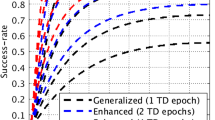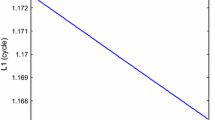Abstract
This paper deals with the problem of detecting and correcting cycle-slips in Global Navigation Satellite System (GNSS) phase data by exploiting the Bayesian theory. The method is here applied to undifferenced observations, because repairing cycle-slips already at this stage could be a useful pre-processing tool, especially for a network of permanent GNSS stations. If a dual frequency receiver is available, the cycle-slips can be easily detected by combining two phase observations or phase and range observations from a single satellite to a single receiver. These combinations, expressed in a distance unit form, are completely free from the geometry and depend only on the ionospheric effect, on the electronic biases and on the initial integer ambiguities; since these terms are expected to be smooth in time, at least in a short period, a cycle-slip in one or both the two carriers can be modelled as a discontinuity in a polynomial regression. The proposed method consists in applying the Bayesian theory to compute the marginal posterior distribution of the discontinuity epoch and to detect it as a maximum a posteriori (MAP) in a very accurate way. Concerning the cycle-slip correction, a couple of simultaneous integer slips in the two carriers is chosen by maximazing the conditional posterior distribution of the discontinuity amplitude given the detected epoch. Numerical experiments on simulated and real data show that the discontinuities with an amplitude 2 or 3 times larger than the noise standard deviation are successfully identified. This means that the Bayesian approach is able to detect and correct cycle-slips using undifferenced GNSS observations even if the slip occurs by one cycle. A comparison with the scientific software BERNESE 5.0 confirms the good performance of the proposed method, especially when data sampled at high frequency (e.g. every 1 s or every 5 s) are available.
Similar content being viewed by others
References
Bayes T (1763) An essay towards solving a problem in the doctrine of chances. Philosophical Transactions of the Royal Society of London, vol 53, pp 370–418. Published posthumously, then reprinted in Biometrika, vol 45, pp 296–315 (1958)
Berger M (1987). Geometry I. Translated from the French by Cole M and Levy S. Springer, Berlin
Betti B, Crespi M and Sansò F (1993). A geometric illustration of ambiguity resolution in GPS theory and a Bayesian approach. Manus Geod 18: 317–330
Beutler G, Bock H, Brockmann E, Dach R, Fridez P, Gurtner W, Habrich H, Hugentobler U, Ineichen D, Jaeggi A, Meindl M, Mervart L, Rothacher M, Schaer S, Schmid R, Springer T, Steigenberger P, Svehla D, Thaller D, Urschl C, Weber R (2006). BERNESE GPS software version 5.0
Blewitt G (1990). An automatic editing algorithm for GPS data. Geophys Res Lett 17(3): 199–202
Bona P (2000). Precision, cross correlation and time correlation of GPS phase and code observations. GPS Solutions 4(2): 3–13
Box GEP and Tiao GC (1992). Bayesian inference in statistical analysis. Wiley, New York
Euler HJ and Goad CC (1991). On optimal filtering of GPS dual frequency observations without using orbit information. Bull Geod 65: 130–143
Gelman A, Carlin JB, Stern HS and Rubin DB (1995). Bayesian data analysis. Chapman & Hall, London
Gundlich B and Koch KR (2002). Confidence regions for GPS baselines by Bayesian statistics. J Geod 76: 55–62
Koch KR (1990) Bayesian inference with geodetic applications. Lecture Notes in Earth Sciences, vol 31. Springer, Berlin
de Lacy MC, Sansò F, Rodriguez-Caderot G and Gil AJ (2002). The Bayesian approach applied to GPS ambiguity resolution. A mixture model for the discrete-real ambiguities alternative. J Geod 76: 82–94
Lichten SM, Bar-Sever YE, Bertiger EI, Heflin M, Hurst K, Muellerschoen RJ, Wu SC, Yunck TP, Zumberge JF (1995) GIPSY-OASIS II: a high precision GPS data processing system and general orbit analysis tool, Technology 2006, NASA Technology Transfer Conference, Chicago, October 24–26
Sansò F and Venuti G (1997). Integer variables estimation problems: the Bayesian approach. Ann Geofisica XL(5): 1415–1431
Teunissen PJG (1997). On the GPS widelane and its decorrelating property. J Geod 71: 577–587
Teunissen PJG and Kleusberg A (1998). GPS for geodesy, 2nd edn. Springer, Berlin
Xu P (2005). Sign-constrained robust least squares, subjective breakdown point and the effect of weights of observations on robustness. J Geod 79: 146–159
Zimmermann F, Haak T, Hill C (2006) The Galileo system simulation facility-validation with real measurement data. ENC06, European Navigation Conference and Exhibition, Manchester, 8–10 May, 2006
Author information
Authors and Affiliations
Corresponding author
Rights and permissions
About this article
Cite this article
de Lacy, M.C., Reguzzoni, M., Sansò, F. et al. The Bayesian detection of discontinuities in a polynomial regression and its application to the cycle-slip problem. J Geod 82, 527–542 (2008). https://doi.org/10.1007/s00190-007-0203-8
Received:
Accepted:
Published:
Issue Date:
DOI: https://doi.org/10.1007/s00190-007-0203-8




